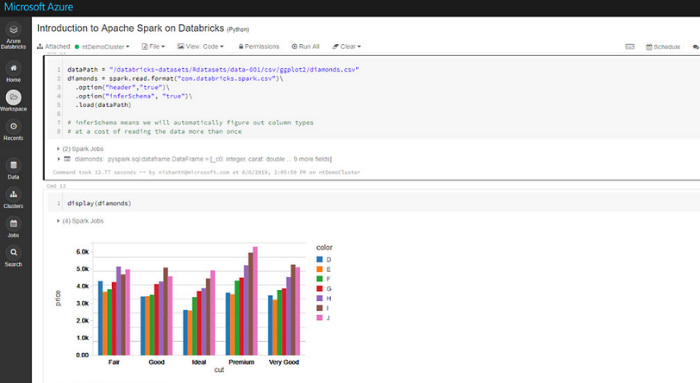Data analysis is an essential part of decision making in any business and one of the main concerns within any company is to find solutions that allow to quickly process and share the huge volume of data produced by its activity from a single platform that allows to respond favorably to these workloads, and this is where Azure Databricks comes into play, one of the most popular options for BI analysts.
What is Azure Databricks and what is it for?
Azure Databricks is a cloud-based platform that combines real-time data analytics, data integration and data science. It is a real-time data analytics solution that runs on Apache Spark, an open source distributed data processing engine that provides high speed and scale for processing large data sets.
It provides an intuitive and collaborative development environment for data analytics and data science, with integrated tools for cleansing, processing and visualization allowing users to run and manage Apache Spark jobs on the Azure Databricks cluster and integrate data with other data sources in Azure, including traditional databases, data warehouses and streaming data.
What data types are supported by Databricks?
Number and Decimal, INT, Float, Interval, VOID, Smallint, String, TimeStamp, Tynynynt, Array, MAP, Struct, Date and Time, BigInt, Bynary, Boolean and Double
What language does it support?
It supports Python, Scala, R, Java and SQL including data science frameworks and libraries such as TensorFlow, PyTorch and scikit-learn.
Who is Azure Databricks aimed at?
It is intended to foster collaborative work between data engineers, machine learning engineers, data scientists, data analysts and others.

Azure Databricks Interface
Why should you choose Azure Data Bricks?
There are several reasons why a company might consider working with Azure Databricks for their data analytics:
- Scalability and flexibility: This means that the company can adjust the size of its Azure Databricks cluster according to its needs and pay only for actual usage. In addition, the platform is optimized to work with large data sets and provides fast and reliable performance.
- Real-time analytics: The enterprise can get real-time results and analytics, enabling it to make faster and better-informed decisions.
- Integrations: Its integrations with other Azure platforms, such as Azure Synapse Analytics and Azure Data Lake Storage, allows you to easily integrate and analyze data from multiple sources.
- Intuitive development environment: Providing the analyst team with an efficient, productive and streamlined environment enabling collaboration on multiple projects at the same time with integrated tools for data cleansing, processing and visualization.
- Processing speed: Leveraging Spark's processing engine enables cluster creation in very few seconds, outperforming most tools on the market.
Use cases
The link that Databricks provides between data sources at their origin and their final destination makes it an ideal solution for the study of data science and engineering, as well as for artificial intelligence, being used for machine learning, streaming or deep learning projects.
But if we describe a more practical example, we can highlight how LaLiga transformed its marketing strategy thanks to the processing of more than 75 million data and hundreds of terabytes of information processed each day as a result of all mobile apps, ticketing or access to stadiums among others, thanks to Azure Data Factory running with Kubernetes and Azure DataBricks.
What do you think? Do you already work with Azure Databricks?